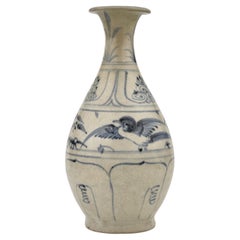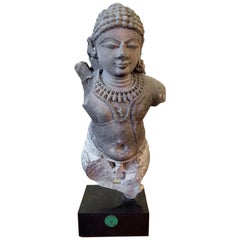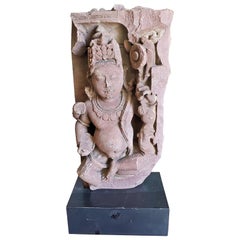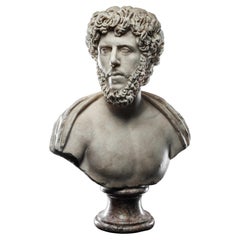15th Century and Earlier Antiquities
Period: 15th Century and Earlier
Color: Gray
Egyptian scarab with pseudo-hieroglyphic, Anra-type
Located in EL CAMPELLO, ES
ITEM: Scarab with pseudo-hieroglyphic, Anra-type
MATERIAL: Steatite
CULTURE: Egyptian
PERIOD: Second Intermediate Period, 1700 – 1550 B.C
DIMENSIONS: 10 mm x 15 mm
CONDITION: Good co...
Category
Egyptian Egyptian Antique 15th Century and Earlier Antiquities
Materials
Stone
An Annamese stoneware with cobalt blue, Hoi An Hoard, Late 15th century
Located in seoul, KR
Lively birds flit across the body of this pear-shaped vase. The cobalt blue of the underpainting remains dark, even though the clear glaze of the surface has worn away after centuries under the sea. There was remarkable variation in the condition of the ceramic...
Category
Vietnamese Ming Antique 15th Century and Earlier Antiquities
Materials
Stoneware
10/11C Pot-Bellied Vishnu Buff Sandstone Sculpture
Located in Dallas, TX
PRESENTING a STUNNING piece of Southeast Asian Antiquity, namely, a 10/11C Pot-Bellied Vishnu Buff Sandstone Sculpture from Central India.
This piece has impeccable Provenance!
So...
Category
Indian Archaistic Antique 15th Century and Earlier Antiquities
Materials
Sandstone
11C Red Sandstone Pot Bellied Vishnu Carving
Located in Dallas, TX
Presenting a stunning 11C Red Sandstone Pot Bellied Vishnu carving.
From Central India.
This piece has impeccable Provenance !
It was purchased by a...
Category
Indian Archaistic Antique 15th Century and Earlier Antiquities
Materials
Sandstone
Ancient Marble Portrait Bust of a Bearded Man possibly Lucius Verus
Located in London, GB
This impressive bust is depicted with head turned slightly to the right and gaze lifted. His eyes are articulated, with the pupils indicated with a drill, giving the face a striking realism. The shoulders are draped with a cloak. Straight brows sit beneath a mass of thickly curling hair, which continues to a full beard. It is worked with great skill, evident in the heavy drill work articulating and highlighting the voluminous curls, and the highly polished surfaces, giving the appearance of soft skin. The contrast between these textures gives a chiaroscuro affect which is one of the main traits of the best Antonine busts.
Roman marble portraits reached their apotheosis of craftmanship and technique under the Antonine emperors, as is evidenced in this masterful bust. The evolution of the style may be traced back to the emperor Hadrian, who was the first emperor to wear a full beard. The articulation of pupils and iris appears on busts of his lover Antinous, a novelty which continued in later Antonine portraits, such as this one. The features of this bust point to a possible identification of Emperor Lucius Verus...
Category
Antique 15th Century and Earlier Antiquities
Materials
Marble
Vishnu Seated on Garuda Buff Sandstone Central India
Located in Dallas, TX
Presenting a stunning piece of Indian antiquity from the 12th century, namely, a Vishnu Buff Sandstone Central India.
From Central India.
This piece has impeccable Provenance !
It...
Category
Indian Archaistic Antique 15th Century and Earlier Antiquities
Materials
Sandstone
Han Dynasty, Antique Chinese Pottery Hu Jar
Located in Sampantawong, TH
Chinese pottery jar decorated with bands of raised lines and a pair of monster masks on the shoulder.
Age: China, Han Dynasty, 206 B.C. - A.D.220
...
Category
Chinese Antique 15th Century and Earlier Antiquities
Materials
Pottery
Celadon Incense Burner with Peony Arabesque Design/Chinese Antique/14th-17th C
Located in Kyoto-shi, Kyoto
This is a Celadon three-legged incense burner with peony arabesque design.
Since the 14th century, Dwarf sedge was planted in this pot to decorate the tea room, so in Japan it is ...
Category
Antique 15th Century and Earlier Antiquities
Materials
Ceramic
Set of Five Antique Han Dynasty Chinese Painted Pottery Figures of Attendants
Located in Sampantawong, TH
A set of five Chinese painted pottery figures of male attendants.
Age: China, Han Dynasty, 206 B.C. - A.D. 220
Size: Height 21 - 23.5 C.M. / Width 6.5 - 7.8 C.M.
Condition: Well...
Category
Chinese Antique 15th Century and Earlier Antiquities
Materials
Pottery
Pair of Han Dynasty Seated Figures
Located in Atlanta, GA
Pair of seated pottery figures, Han dynasty (2nd century BC to 2nd century AD). The taller of the two sits very still and upright, his hands folded into his sleeves, gazing straight ...
Category
Chinese Antique 15th Century and Earlier Antiquities
Materials
Pottery
Roman portrait head of a Patrician
Located in EL CAMPELLO, ES
ITEM: Portrait head of a Patrician
MATERIAL: Marble
CULTURE: Roman
PERIOD: 1st Century B.C
DIMENSIONS: 250 mm x 175 mm x 215 mm (without stand), Life-siz...
Category
European Classical Roman Antique 15th Century and Earlier Antiquities
Materials
Marble
Archaic Jade Bi, Liangzhu Period
Located in Atlanta, GA
Museum-quality Chinese jade Bi from the Liangzhu period (3300-2200 BC). For the Liangzhu, jade was the primary material through which the secular and religiou...
Category
Chinese Antique 15th Century and Earlier Antiquities
Materials
Jade
2nd Century Indian Red Sandstone Fragment of a Woman
Located in Dallas, TX
Presenting a stunning little piece of Southeast Asian Indian Antiquity, namely, a Double-sided 2nd Century Red Sandstone Fragment of a Woman.
From India, Uttar Pradesh, Mathura.
This piece has impeccable Provenance !
It was purchased by a Private Dallas Collector at Christie’s New York Auction on 31st March 2005. Sale Number 1492, Lot No. 43.
Christie’s operate a twice yearly auction of Southeast Asian Art & Antiquities in New York in the months of March and September.
The sculpture was described as “Property of a European Estate. A Double-sided Red Sandstone Fragment of a Woman. India, Uttar Pradesh, Mathura, Circa 2nd Century.”
“Both sides similarly depicting the lower body with a flared sash at left and remains of chained belt: marked with an accession number 1931 on reverse. 8 in (29.2 cm.) high”
Provenance: Collection of Prince and Princess Aschwin zur Lippe-Biesterfeld, acquired on 1958?.
It carried an Auction estimate of USD 3,000 to USD 5,000 and Sold for USD 2,880 (not including Buyers Premium).
Allowing for inflation alone this would be over $6,300 in today’s value.
It has substantially increased in value over the years as a RARE piece from a prestigious Collection and a RARE piece of antique Asian antiquity...
Category
Indian Medieval Antique 15th Century and Earlier Antiquities
Materials
Sandstone
Han Dynasty, a Set of Antique Chinese Painted Pottery Attendants
Located in Sampantawong, TH
A set of Chinese painted pottery attendants.
Age: China, Han Dynasty, 206 B.C. - A.D. 220
Size: Height 18.4 - 31 C.M. / Width 7.8 - 9.7 C.M.
Condition: Well-preserved old burial con...
Category
Chinese Antique 15th Century and Earlier Antiquities
Materials
Pottery
9th Century Stone Durga from Java-Stone Masterpiece, Large, Authentic - 9198
Located in Ukiah, CA
Masterpiece 9th century stone durga from Java. This sculpture is one of the finest I've had the pleasure of offering in over 30 years. The Deep spiritual presence is palpable in the ...
Category
Southeast Asian Antique 15th Century and Earlier Antiquities
Materials
Stone
13/14thC Large Thickly Cast Iron Korean Buddha, 9020
Located in Ukiah, CA
Very rare large thickly cast iron Korean Buddha (a magnet sticks to it). In an extremely early backless style. I believe this piece could be as late as 1...
Category
Korean Antique 15th Century and Earlier Antiquities
Materials
Iron
Ancient Bactrian Marble Idol Staff Sceptor
Located in Vosselaar, BE
A large Bactrian marble staff circa late 3rd-2nd millennium BCE. The Bactrian culture was discovered by Soviet archeologists in the 1970s in Afghanistan. Also called the Oxus culture...
Category
Afghan Antique 15th Century and Earlier Antiquities
Materials
Marble
Majestic Prancing Horse, Tang Dynasty, China '618-907 AD', TL Test by Kotalla
Located in San Pedro Garza Garcia, Nuevo Leon
Magnificent prancing horse in orange terracotta with traces of polychrome paint. Springing its right leg with a lively position and an expressive look. With a finely decorated saddle...
Category
Chinese Tang Antique 15th Century and Earlier Antiquities
Materials
Terracotta
Rare Samarkanda or Bokara Almoner Trays
Located in Alessandria, Piemonte
Very antique and rare almoner trays from Samarkanda or Bokara - Ghaznevide Dinasty from 11th-12th century A.D.
Interesting for Your desk!
From private collection -
O/1655.
Category
Uzbek Other Antique 15th Century and Earlier Antiquities
Materials
Copper
Tang Dynasty Court Official in Sancai Glazed Robes, China '618-907' - TL Tested
Located in San Pedro Garza Garcia, Nuevo Leon
A Tang dynasty sancai (three color) glazed pottery model of a Taoist official, TL tested by Ralf Kotalla - worldwide oldest private laboratory specialized for genuine thermoluminesce...
Category
Chinese Tang Antique 15th Century and Earlier Antiquities
Materials
Terracotta
Ancient Buddhist Stone Tabletop Altar with a Lotus Flower
Located in Antwerp, BE
An exceptional and very early Buddhist stone altar equipped with two handgrips for moving it to the spot of the planned sacrifice. Carved by hand from a si...
Category
Asian Hellenistic Antique 15th Century and Earlier Antiquities
Materials
Schist
Elegant Han Dynasty Terracotta Warrior - China '206 BC - 220 AD'
Located in San Pedro Garza Garcia, Nuevo Leon
Impressive terracotta warrior representing a banner bearer gripping a wooden staff with his hands (dematerialized through the ages); his gaze is ser...
Category
Chinese Han Antique 15th Century and Earlier Antiquities
Materials
Terracotta
Han Dynasty Green Glazed Covered Storage Jar
Located in Austin, TX
A wonderful Han Dyansty (206 BC-200 AD) storage vessel. The circular body set upon three legs and fitted with a lid. The entirety covered in heavy leaded green glaze, imitating bronz...
Category
Chinese Han Antique 15th Century and Earlier Antiquities
Materials
Pottery
Magnificent Court Attendants in Terracotta - Ming Dynasty, China 1368-1644 AD TL
Located in San Pedro Garza Garcia, Nuevo Leon
A magnificent pair of male and female courtiers from the Ming Dynasty (1368-1644 CE) in excellent condition. They are wearing traditional Daopao robes in green and black garments wit...
Category
Chinese Ming Antique 15th Century and Earlier Antiquities
Materials
Terracotta
Eastern Han Dynasty Terracotta Barn Workshop, China '206BC - 220AD' Ex-Museum
Located in San Pedro Garza Garcia, Nuevo Leon
Slab pottery constructed barn workshop having a peaked roof – open walled form with a mechanical pounder and a large round covered storage container. Light blue-green mottled glazed surface with some iridescence patina to the glaze.
Condition: Intact, excellent condition, an unusual example.
Provenance: The Living Torah Museum, Brooklyn; ex. Sands of Time, 2002.
Sculptural effigies of domesticated animals were often interred in the tombs of nobility and elite members of the social hierarchy. Models like this one were made to represent everything from simple goat or pig pens to the most elaborate towers and palaces. Because very few ancient Chinese buildings have survived intact, these models, along with descriptions from ancient texts, give a good representation of what the buildings might have looked like.
This fantastic piece is accompanied by a Certificate of Authenticity.
Burial figurines of graceful dancers, mystical beasts, and everyday objects reveal both how people in early China approached death and how they lived. Since people viewed the afterlife as an extension of worldly life, these figurines, called mingqi, sometimes referred as “spirit utensils” or “vessels of ghosts” disclose details of routine existence and provide insights into belief systems over a thousand-year period. For the first time in Chinese history, we have images of rural and daily life during the Han in the form of contemporary...
Category
Chinese Han Antique 15th Century and Earlier Antiquities
Materials
Terracotta
6 Elegant Ming Dynasty Court Attendants in Glazed Terracotta, China 1368-1644 AD
Located in San Pedro Garza Garcia, Nuevo Leon
A fine set of a six court attendants as in the Forbidden City of Beijing, elegantly dressed in a Green & Red Daopao – a traditional men’s formal attire from the Ming Dynasty dated 1368-1643 A.D. – with glazed robes and Red Pigment remains in their hat and belts. They stand in an honorary posture atop a red plinth, some with orifices in their hands, where spirit objects were placed to comfort or satisfy the deceased. The heads are detachable, as often seen on the larger figures from this period.
They are accompanied by a Certificate of Authenticity, and Certificate of Expertise by Jean-Yves Nathan - a leading authority specialized in Far East Archaeology from the CEDEA (The European Confederation of Art Experts).
Burial figurines of graceful dancers, mystical beasts, and everyday objects reveal both how people in early China approached death and how they lived. Since people viewed the afterlife as an extension of worldly life, these figurines, called mingqi, sometimes referred as “spirit utensils” or “vessels of ghosts” disclose details of routine existence and provide insights into belief systems over a thousand-year period.
The Ming dynasty was the ruling dynasty of China – then known as the Empire of the Great Ming – for 276 years (1368–1644 AD). Founded by Chu Yuan-chang, the rebel leader that was successful in removing the mongols from the throne. Chinese control was re-asserted in China and eastern Asia. Literature became more important, schools were created, and the justice system was reformed. The Ming dynasty is described by some as "one of the greatest eras of orderly government and social stability in human history,” was the last imperial dynasty in China ruled by ethnic Han Chinese.
The practice of burying ceramic objects with the deceased went into decline from the 10th to the 14th Century AD. There was a revival in placing miniature representations of glazed terracotta objects such a furniture, food offerings, horses, miniature statues...
Category
Chinese Ming Antique 15th Century and Earlier Antiquities
Materials
Terracotta
Ancient China Monumental Stone Ram Han Dynasty, 206BC-220AD
Located in South Burlington, VT
China, a large votive model of a stone ram, Han dynasty (206BC-220AD)
Dimensions: 45cm, 18 inches high and 65cm, 26 inches length and 25cm, 10 inches wi...
Category
Chinese Han Antique 15th Century and Earlier Antiquities
Materials
Limestone
Ming Dynasty Celestial Deity Head Carved in Stone - China '1368-1644 AD'
Located in San Pedro Garza Garcia, Nuevo Leon
Wonderful celestial deity head with a jovial expression in stone with a finely engraved cap. It is mounted on a custom lucite base.
This piece is accompanied by a Certificate of Authenticity, and Certificate of Expertise by Jean-Yves Nathan - Specialist in Asian Arts for the CEDEA (The European Confederation of Art Experts).
The Ming dynasty was the ruling dynasty of China – then known as the Empire of the Great Ming...
Category
Chinese Ming Antique 15th Century and Earlier Antiquities
Materials
Stone
Ming Dynasty Chinese Countryside Villa - TL Tested
Located in San Pedro Garza Garcia, Nuevo Leon
Extremely rare Chinese model of a countryside villa for the royal courtiers and ministries of the Ming Dynasty -1368-1644 AD- showing three guest houses and one main entry. The villa is surrounded by a cuadrangular wall painted with bucolic scenes of garden, mountains, and bamboo forests. The roof tiles are glazed in green enamel with yellow finials – as the ones in the forbidden city – typical from the Ming epoch. Truly a museum piece. The doors swivel and are painted in ochre. State of preservation: impeccable mint condition with original paintings, all of the original parts are complete, except for one house which is missing part of the plinth (broken during transport). Each part has been tested for authenticity, consisting of eight separate TL tests...
Category
Chinese Ming Antique 15th Century and Earlier Antiquities
Materials
Terracotta
Tang Dynasty Imposing Terracota Lokapala Standing in Menacing Pose - TL Tested
Located in San Pedro Garza Garcia, Nuevo Leon
Imposing Lokapala figure standing in menacing pose. Terracotta with traces of old color pigments. China, Tang dynasty (618-907 AD.) Museum piece.
Lokapalas according to the Buddhist...
Category
Tang Antique 15th Century and Earlier Antiquities
Important Ancient Chinese Effigy Pug Dog, Ming Dynasty 1368-1644
Located in South Burlington, VT
China, a carving of a canine “Pug”, Ming Dynasty, 1368-1644 CE
Dimensions: 38 cm, 15” High
Photographs taken indoors and out of doors for your viewing pleasure.
The hand carved limestone beast shown on its haunches with naturalistic joyful expression and a well defined compact head, ears, noes, eyes, feet, and tail parted to one side on reverse with distinctive collar ornament seated four square on a thick base all-over showing a weathered surface from significant age.
Formerly exhibited “Asia Week” New York City, Fuller Building, Hutton Gallery 2006.
Provenance: ex collection luoyang, Henan Province, China.
Includes custom display base as shown
Catalog reference: 35 years collecting 35 treasures, Number 35, p.76 (photo)
In ancient China, it is a well-known fact that several types of small dogs were bred and were favored pet gifts between emperors and kings including Lion Dogs, Pekingese and Lo-sze breeds. Some Lo-sze are pictured wearing collars with bells a frequent combination fancied by European royalty of the seventeenth and eighteenth centuries. Lo-sze or pugs were prized for their compact body, good bones, flat face, square jaw, short coat, curled tail, side set back ears, and temperate disposition.
History:
Placing stone animals in important tombs can be traced back at least to the Qin Dynasty (221-206 BCE), some two thousand years ago. In ancient times, stone animals and human figures placed before imperial tombs symbolized royal power and privilege in addition to decorative functions.
The first Ming tomb...
Category
Chinese Ming Antique 15th Century and Earlier Antiquities
Materials
Limestone
Greek slingshot with MER and NA
Located in EL CAMPELLO, ES
ITEM: Slingshot with MER and NA
MATERIAL: Lead
CULTURE: Greek
PERIOD: 4th Century B.C
DIMENSIONS: 12 mm x 26 mm
CONDITION: Good condition
PROVENANCE: Ex English private collection, acquired between 1980 – 1990
PARALLEL: DRASKOWSKI, N., and WEISS, P., Neue griechische Schleuderbleie. Tissaphernes und weitere Kommandeure, p. 148 – 149
Comes with Certificate of Authenticity and Export license (If you live outside the European Union, We will have to apply for an export licence for your country and shipping will take 3 to 5 weeks.)
Sling, implement for propelling missiles, one of the first missile weapons used in warfare. It consisted of a small strap or socket of leather to which two cords were attached. The warrior, or slinger, held the ends of the cords in one hand, placed the missile snugly in the strap, and whirled the socket and missile rapidly around his head; by letting go of one cord at the right moment, the slinger could let the missile fly out of the socket at a high speed.
In the Roman army...
Category
Greek Classical Greek Antique 15th Century and Earlier Antiquities
Materials
Lead
Greek slingshot with torch and lance
Located in EL CAMPELLO, ES
ITEM: Slingshot with torch and lance
MATERIAL: Lead
CULTURE: Greek
PERIOD: 4th Century B.C
DIMENSIONS: 18 mm x 34 mm
CONDITION: Good condition
PROVENANCE: Ex English private collection, acquired between 1980 – 1990
Comes with Certificate of Authenticity and Export license (If you live outside the European Union, We will have to apply for an export licence for your country and shipping will take 3 to 5 weeks.)
Sling, implement for propelling missiles, one of the first missile weapons used in warfare. It consisted of a small strap or socket of leather to which two cords were attached. The warrior, or slinger, held the ends of the cords in one hand, placed the missile snugly in the strap, and whirled the socket and missile rapidly around his head; by letting go of one cord at the right moment, the slinger could let the missile fly out of the socket at a high speed.
In the Roman army...
Category
Greek Classical Greek Antique 15th Century and Earlier Antiquities
Materials
Lead
Greek slingshot with bee
Located in EL CAMPELLO, ES
ITEM: Slingshot with bee
MATERIAL: Lead
CULTURE: Greek
PERIOD: 4th Century B.C
DIMENSIONS: 15 mm x 30 mm
CONDITION: Good condition
PROVENANCE: Ex English private collection, acquired between 1980 – 1990
Comes with Certificate of Authenticity and Export license (If you live outside the European Union, We will have to apply for an export licence for your country and shipping will take 3 to 5 weeks.)
Sling, implement for propelling missiles, one of the first missile weapons used in warfare. It consisted of a small strap or socket of leather to which two cords were attached. The warrior, or slinger, held the ends of the cords in one hand, placed the missile snugly in the strap, and whirled the socket and missile rapidly around his head; by letting go of one cord at the right moment, the slinger could let the missile fly out of the socket at a high speed.
In the Roman army...
Category
Greek Classical Greek Antique 15th Century and Earlier Antiquities
Materials
Lead
Greek slingshot with torch and unidentifiable text
Located in EL CAMPELLO, ES
ITEM: Slingshot with torch and unidentifiable text
MATERIAL: Lead
CULTURE: Greek
PERIOD: 4th Century B.C
DIMENSIONS: 19 mm x 33 mm
CONDITION: Good condition
PROVENANCE: Ex English private collection, acquired between 1980 – 1990
Comes with Certificate of Authenticity and Export license (If you live outside the European Union, We will have to apply for an export licence for your country and shipping will take 3 to 5 weeks.)
Sling, implement for propelling missiles, one of the first missile weapons used in warfare. It consisted of a small strap or socket of leather to which two cords were attached. The warrior, or slinger, held the ends of the cords in one hand, placed the missile snugly in the strap, and whirled the socket and missile rapidly around his head; by letting go of one cord at the right moment, the slinger could let the missile fly out of the socket at a high speed.
In the Roman army...
Category
Greek Classical Greek Antique 15th Century and Earlier Antiquities
Materials
Lead
Greek slingshot with (…)EM(…)
Located in EL CAMPELLO, ES
ITEM: Slingshot with (…)EM(…)
MATERIAL: Lead
CULTURE: Greek
PERIOD: 4th Century B.C
DIMENSIONS: 15 mm x 29 mm
CONDITION: Good condition
PROVENANCE: Ex English private collection, acquired between 1980 – 1990
Comes with Certificate of Authenticity and Export license (If you live outside the European Union, We will have to apply for an export licence for your country and shipping will take 3 to 5 weeks.)
Sling, implement for propelling missiles, one of the first missile weapons used in warfare. It consisted of a small strap or socket of leather to which two cords were attached. The warrior, or slinger, held the ends of the cords in one hand, placed the missile snugly in the strap, and whirled the socket and missile rapidly around his head; by letting go of one cord at the right moment, the slinger could let the missile fly out of the socket at a high speed.
In the Roman army...
Category
Greek Classical Greek Antique 15th Century and Earlier Antiquities
Materials
Lead
Bactrian Ritual Object
Located in Coral Gables, FL
Bactrian culture, Afghanistan. 3rd or early 2nd Millennium B.C.
Category
Afghan Other Antique 15th Century and Earlier Antiquities
Bactrian Ritual Object
Located in Coral Gables, FL
Bactrian ritual object, Bactrian culture, Quetta, Afghanistan 3rd or early 2nd Millennium B.C.
Category
Afghan Other Antique 15th Century and Earlier Antiquities
Recently Viewed
View AllMore Ways To Browse
Chinese Opium Pipes
Desert Samurai
Greco Bactrian
19th Century Burmese Thai Buddha
Samurai Hat
Used Polo Boots
Antique Chinese Corbels
Opium Lamp
Pottery Chinese Immortals
Horse Hair Ceramic Art
Antique Pig Figurine
Antique Pig Figurines
Khmer Goddess
Antique Chinese Coconut
Antique Asian Porcelain Dolls
Asian Lady Figurine
The Battle For Hermes
Chinese Terracotta Army Warriors




